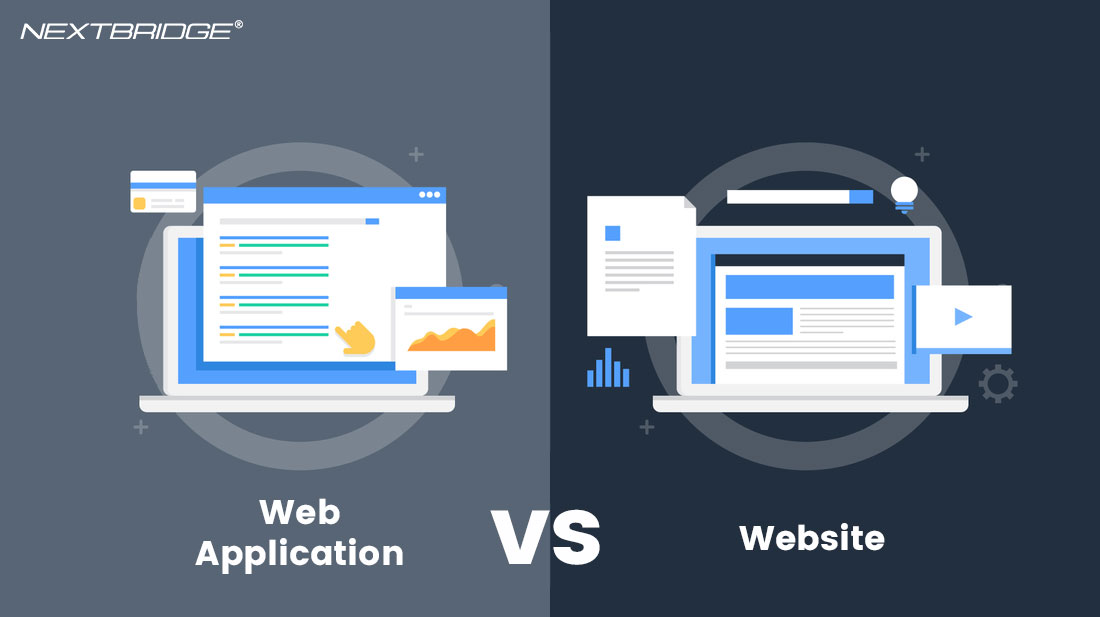Maintenance Plan Process
Contact an account manager
 Back to all articles
Back to all articles


Have you ever thought about whether you are on a website or a web page while using it? Almost no one does, surprising, right! For most users the difference between a website and a web page is not much. However, one is different from the other.
How to choose the right one for your business? What is your business about and will users be interacting with it through server requests? Answers to this question will define what is right for you and your business.
You will learn the difference between a website and a web application. When to choose one over the other. Which is right for your business.
Website is a collection of pages that are interlinked and collected on one domain. Collection of pages having the same domain name is also known as a website.
A website is static, meaning no requests are sent to the server by users. Usually a website has a navigation bar, body content, and a footer. Landing pages, blog website, portfolio are also types of websites. Wikipedia is an example of a website.
Different websites can have different domain identifiers. Like:
Related: The best approach to design any website and web app.
Unlike desktop or mobile applications that run locally on the device, web applications run on the web. In simple terms you can say that web applications are more complex to develop, interactive, and dynamic.
Unlike websites, the purpose of web application is more than content display. Users interact with web applications through buttons, forms, uploading or downloading pictures and videos, buying items, and adding their information to the website.
The aim of a web application is user interaction and engagement. Users send requests to the server and in response an appropriate response is shown on the screen. YouTube, Facebook, Twitter, and all the e-Commerce websites are examples of web apps.
Here are typical functions that any web application can perform:
The difference between website and web application is becoming more of a gray area than black and white. Improving technology, single page applications, progressive web apps, and web 3 apps.
SPA is a single static web page with integrated interactive dynamic elements. Email is an example of a single page web application. On one web page you can create new email, open and read, send and receive notifications, and delete emails; while the rest of the page like navigation bar, side bar, and footer remain static.
A web development framework that takes leverage of features and extensions, runs on the web but is used for mobile apps, is a progressive web application. Like mobile applications it can also run offline and push notifications. If a web app is a progressive one you can add it to your home screen and use it like an application, even though it is not.
Youtube is now a progressive web app, the install button at right in the address bar is how you can add it to your device and use it like a native application.
Web 3.0 applications take the advantage of semantic web elements, user engagement, user behavior, widgets, and drag - drop features to consolidate dynamic content.
The main difference between the two is a simple one. A website is a collection of web pages interlinked together and collected under one domain name, the pages are static and users do not send requests to the server. Conversely, users interact with web applications in various ways, it is dynamic and accessible through any web browser. Web applications can act like a native application just like mobile or desktop applications.
The backend of web applications is more sophisticated and built using programming languages like Python, JavaScript etc. Different tools, frameworks, and server configurations are also used.
Following are the main difference between websites and web applications:
| Aspects | Website | Web Application |
| User interaction | Websites have written and visual content. Users can only see and read or copy it. | User interacts with the website through various ways sending requests to the server. |
| Content type | Websites have static content. | Web applications have dynamic content and are intended for user interaction. |
| Complexity | Building a website is fairly simple.A website exhibits the collected information and data on a precise page. | Web apps have complex functionalities and backend connections. |
| Authentication | Websites do not require user or other website authentication. | User authentication and external site authentication is present. |
| Deployment | To update minor changes the HTML code needs to be updated and re-compiled. | Changes can be reflected with hot reloading. |
| Compilation | Pre-compilation not required. | Pre-compilation is required before deployment. |
Before you select one and start development there are a few questions you need to ask yourself. Let’s have a look at what those questions are.
The selection depends on your requirements and what your audience needs. For instance, if you are going to release a mobile application. You can promote your application and engage users just by building a landing page and getting leads from there. When needed you can update the website to inform users about any changes, new releases, features, or promotions.
Also, check out the best landing page builders companies are using.
For instance, if your requirement is an “eCommerce store” that sells hats then a web application is the right choice. Because you want users to interact with more and keep them engaged. On top of that, you do not want any customers to bounce off because they cannot run it on their mobile app or because of poor user experience. So, web applications are a better option.
Google docs is a great example of web application. It can run offline and store the data locally, when you go online it is synced with the cloud. It is dynamic and updateable so any member of the team can access and view the file and make changes.
Summary
A website is to present users with information and try to convert them into clients. Web apps are to engage users by allowing them to interact through various methods. The only way to choose between the two is what is your business requirement.
If you cannot choose between the two, worry not. We are here to assist you, we can also help you create one for your business. Contact our representative directly or book a consultation so we can discuss whether your business requires a web app or a website.

Commitment to excellence



